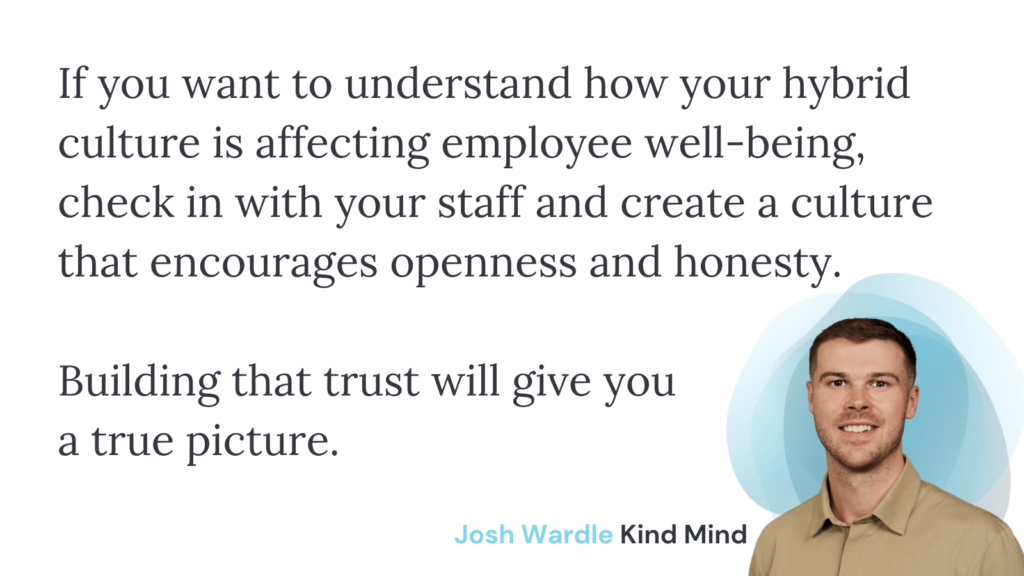We’ve all had a few years to work out how to implement hybrid working, but what we haven’t done is dive into how your hybrid work culture could be impacting your bottom line.
In this blog post, as part of our hybrid series, we want to discuss company culture, so you know what the research shows and can use that to mirror what may be happening in your business. We’ll also give you a guide to help you monitor how your culture shapes up.
Let’s dive in.
The positive effects of an excellent hybrid work culture
Hybrid working can promote a more flexible, adaptable, and responsive company culture that values employee well-being, creativity, and innovation. You’ll see productivity and engagement rise as a result of:
- Increased employee flexibility – By allowing employees to work from different locations, they can improve their work-life balance and reduce the stress of commuting and rigid schedules.
- Improved employee mental health – One of the most significant benefits to the workplace and your company culture must be an individual’s improved mental health, which increases engagement.
- Improved employee satisfaction and retention – Hybrid working can boost employee satisfaction and retention by giving staff more control over their work environment, job flexibility, and through greater trust from their employer.
- Access to a broader talent pool – Employers who offer a hybrid option are more likely to recruit and retain employees. They also broaden their talent pool by providing work to those who can only work on-site part-time (which is great for young families, caregivers and those with impairments and disabilities).
- Better workplace integration – Hybrid working models can foster a more inclusive and diverse workplace culture by accommodating different work styles, caregiving responsibilities, and personal needs.
Overall, our research has shown that the positive effects of an excellent hybrid work culture can far outweigh alternative working models.
There is, of course, a point at which there can be adverse cultural effects. Let’s discuss those now so you can know what to look for.
The adverse effects of a bad hybrid culture
While hybrid working can have several positive effects on company culture, it can also have some adverse reactions where things aren’t working well, such as:
- Communication and collaboration challenges – Hybrid working can create problems due to the physical distance between team members, resulting in miscommunication, isolation, and reduced productivity.
- Potential for a two-tier system – If employees who work remotely feel excluded or disadvantaged compared to those who work on-site, this can lead to resentment and disengagement. The same is true for those with jobs that cannot be completed remotely – they often feel less catered to than hybrid employees.
- Loss of team spirit and social cohesion – If adverse reactions to hybrid working continue, it can erode the sense of team spirit and social cohesion from working together in the same physical space, impacting collaboration, innovation, and morale.
- Reduced oversight and management – Managers can also find it harder to monitor employee performance and ensure everyone is working towards the same goals, leading to a lack of accountability and clarity.
So how do you avoid potentially harmful situations? It’s about striking a balance that starts with learning to monitor your hybrid work culture.

How to monitor your hybrid culture
Monitoring company culture in a hybrid working environment can be challenging. However, there are several strategies you can use to keep tabs on your workforce and ensure that perceptions remain positive and productive.
- Check-in with employees regularly – Schedule regular check-ins with your employees, whether they are in the office or working remotely. Use these meetings to gauge their feelings about their work and the company culture. Ask them questions about their job satisfaction, interactions with colleagues, and any concerns they may have.
- Use online communication tools – Take advantage of the many communication tools available, such as instant messaging, video conferencing, and email, to keep in touch with your team. These platforms foster community and information sharing, keeping everyone connected.
- Encourage feedback – Create a culture of open communication by encouraging employees to share their thoughts and opinions on culture and policy. Provide anonymous feedback mechanisms, such as surveys, suggestion boxes, or online forms, to ensure employees feel comfortable sharing their honest thoughts.
- Monitor productivity and engagement – Use performance metrics, such as output, quality of work, and attendance, to measure productivity. Use surveys or other tools to measure employee engagement and identify improvement areas.
- Emphasise wellness through the hybrid transition and beyond – We have already created a guide to the hybrid working transition. We recommend a good read of that to help you account for wellness throughout the process and beyond.
- Design a solid hybrid working policy – Make sure your policy covers the clarity and consistency employees seek to thrive under your working model.
- Lead by example – You set the tone for company culture as a leader. Ensure that you are modelling the behaviour you want to see in your employees. Be transparent, communicative, and empathetic by encouraging collaboration and teamwork.
Using these strategies, you can monitor and maintain a more balanced and positive company culture, even in a hybrid working environment.
In our following guide to the hybrid work model, we want to talk to you about your tech – join us over here!






